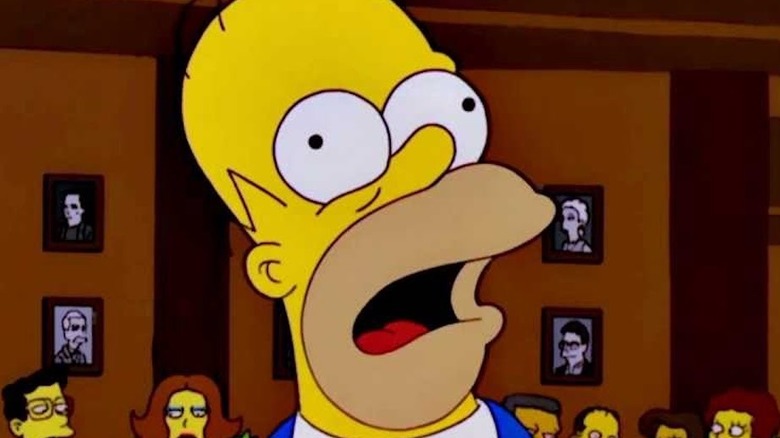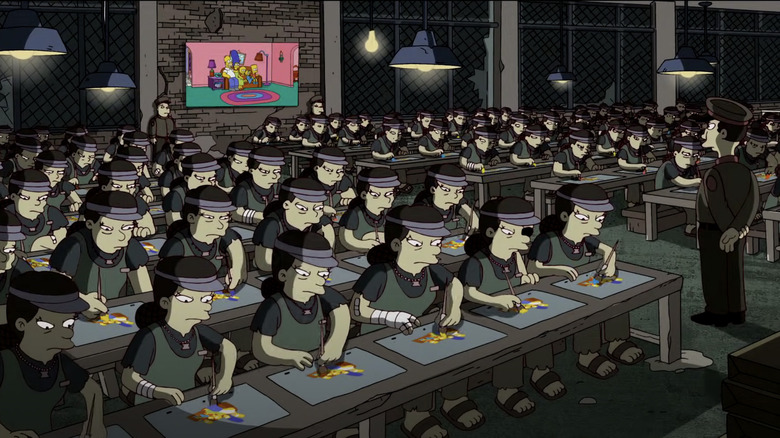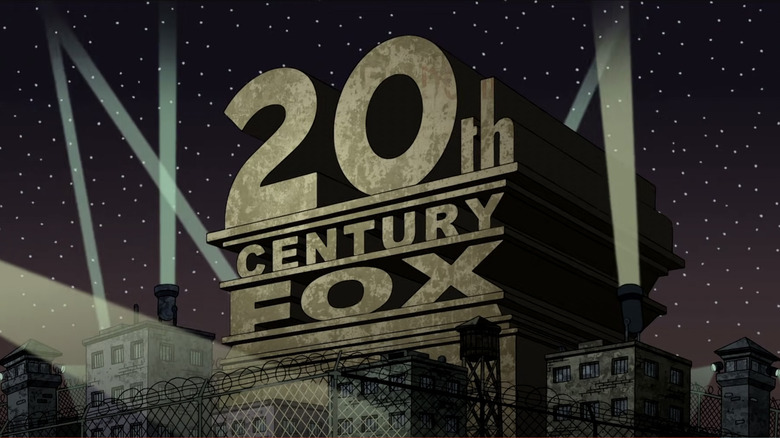The Disturbing Simpsons Couch Gag Fans Thought Was Way Too Depressing
While there are lots of reasons "The Simpsons" has engaged audiences for as long as it has — 33 seasons and counting! — one of the primary reasons is the constantly changing "couch gag." While we wouldn't go as far as The Guardian did when they asked if couch gags are the only aspect of the show worth checking out, the varying "Simpsons" opening credits do keep people tuning in.
Almost as old as the series itself, the first couch gag debuted in Season 1, Episode 2, "Bart the Genius," way back in January 1990, per Submarine Channel. "The Simpsons" started out as short, animated bumpers surrounding the commercial breaks of a live-action show — the first self-named sketch series from brilliant actor and comic Tracey Ullman. "The Tracey Ullman Show" aired from 1987 to 1990 on the then-fledgling Fox network, setting the tone for its new, irreverent brand of television. Julie Kavner and Dan Castellaneta, who respectively voice Marge and Homer Simpson, were members of Ullman's cast, per Den of Geek. The shorts began in Episode 3 of the variety show on April 19, 1987, and captured the zeitgeist so successfully that they spun off into their own show, which premiered on December 17, 1989. The rest, as they say, is history.
Since then, the iconic opening sequence has been taken over by guest animators several times, often with weird and disturbing results. But there was at least one couch gag that many Simpsons fans thought went a little too far.
Of all the weird and disturbing couch gags, Banksy takes the cake
With more than 700 episodes in "The Simpsons" history, guest artists have created a number of couch gags, including "Ren & Stimpy" creator John Kricfalusi, and animators Steve Cutts, Don Hertzfeld, and Bill Plympton (who's done it many times). There was even a "Robot Chicken"-style Claymation couch gag. While some have been weird and disturbing, few were as controversial as the gag used early in the show's 22nd season. For the season's 3rd episode, titled "MoneyBART," the creators hired elusive and unidentifiable graffiti artist Banksy for the couch gag. Famously known for his anti-establishment pranks, Banksy's sequence took potshots at the animation and merchandising industries, and the Fox network.
As the Simpson family sits on the couch, the camera zooms out, revealing a dark, grimy sweatshop filled with human bones, hazardous waste, and sickly animators slaving over hand-painted animation cells. We tour the sweatshop and witness horrible human and animal cruelty, including a barefooted child with a vat of chemicals, a chained-up panda, and a near-death unicorn used to build "Simpsons"-related products. Though controversial when it aired in 2010, with real South Korean animation workers protesting the incorrect depiction of their conditions and Fox itself pulling YouTube clips down for copyright infringement, showrunner Al Jean told The New York Times that it was all according to plan. "Obviously, the animation to do this was pricey. I couldn't have just snuck it by Fox," Jean said. He added, "I haven't been fired yet, so that's a good sign."
Fans aren't really laughing about Banksy's satire
While best-of lists call the Banksy couch gag dark but satirically funny, fans on Reddit's r/couchgags don't agree. Though u/Mystic5hadow's thread simply said "TIL that Banksy made the intro for an episode of the Simpsons," it drummed up many comments describing it as "grim," "dark," and "depressing." u/MoreGull joked, "That escalated quickly," while u/Sniggity recalled its initial 2010 showing, noting, "I remember this one the day it aired. I wanted to laugh, but it was so eerie, sad, and truthful." u/KungFooKangaroo even admitted, "I don't feel like watching anymore."
Some commented on the "Banksy-ness" of it, as u/Trunamke shared, "Felt very banksy. This was hyperbolic demonstration on industry practices to make items for our enjoyments." The most telling comment came from u/MicooDA, who wrote, "Banksy doing what Banksy does best. Protesting the Machine by becoming part of it."
Fans weren't the only people disappointed with Banky's depiction. "Most of the content was about degrading people from Korea, China, Mexico, and Vietnam," animator Nelson Shin told Time. "If Banksy wants to criticize these things ... I suggest that he learn more about it first." But Al Jean set the record straight with The New York Times. "It's very fanciful, far-fetched. None of the things [Banksy] depicts are true," the longtime showrunner said. "That statement should be self-evident, but I will emphatically state it."


